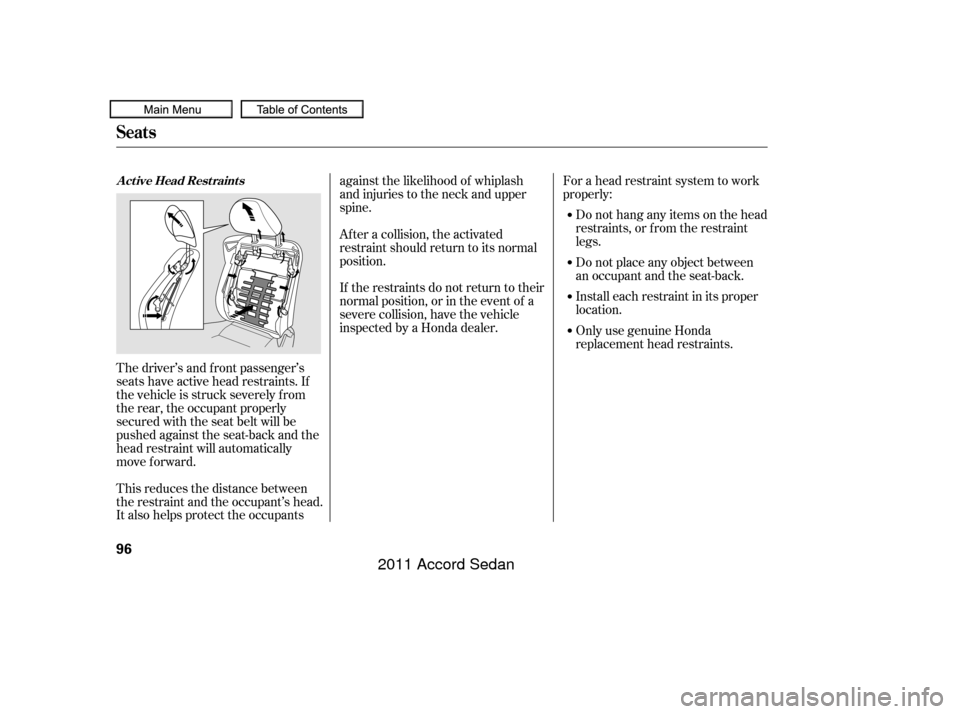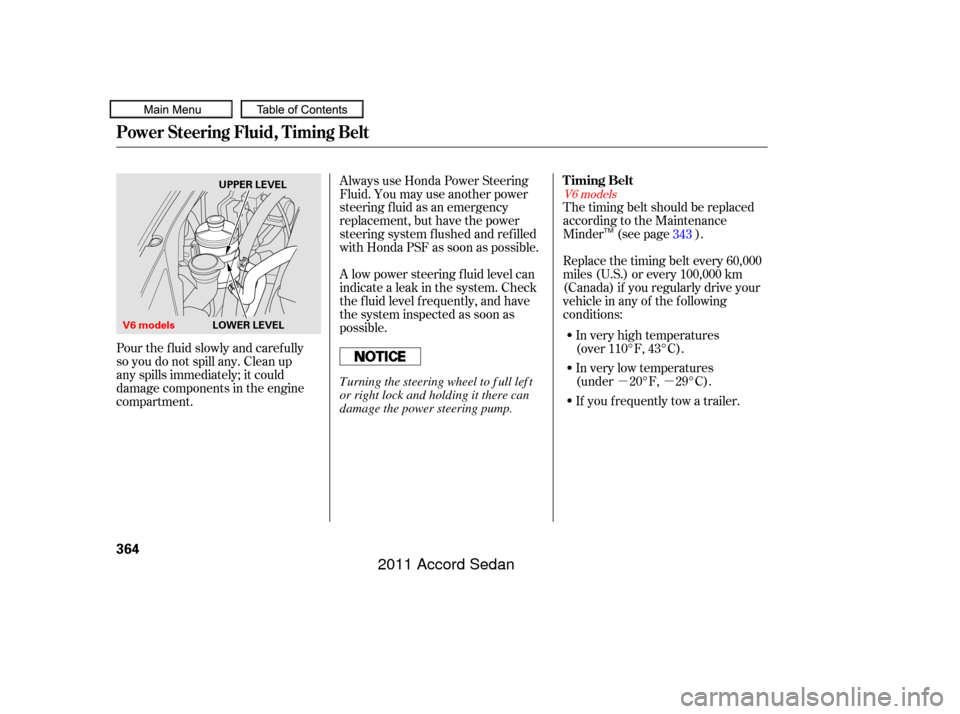Page 99 of 454

The driver’s and f ront passenger’s
seats have active head restraints. If
the vehicle is struck severely f rom
the rear, the occupant properly
secured with the seat belt will be
pushed against the seat-back and the
head restraint will automatically
move forward.
This reduces the distance between
the restraint and the occupant’s head.
It also helps protect the occupantsagainst the likelihood of whiplash
and injuries to the neck and upper
spine.
For a head restraint system to work
properly:
Do not hang any items on the head
restraints, or f rom the restraint
legs.
Do not place any object between
an occupant and the seat-back.
Install each restraint in its proper
location.
Only use genuine Honda
replacement head restraints.
Af ter a collision, the activated
restraint should return to its normal
position.
If the restraints do not return to their
normal position, or in the event of a
severe collision, have the vehicle
inspected by a Honda dealer.
Seats
A ct ive Head Rest raint s
96
10/06/18 15:54:47 31TA5630_101
2011 Accord Sedan
Page 100 of 454
When storing cargo, you can move
therearcentershoulderbeltoutof
the way by removing the belt from
the guide. The back of the rear seat folds down,
giving you direct access to the trunk.
The seat-back is released f rom inside
the trunk.Remove any items from the seat
beforeyoufolddowntheseat-back.
Make sure the rear seat armrest is
stored.
To release the seat-back from inside
the trunk, pull the release under the
trunk panel. Push the seat-back
down f rom inside the trunk, or pull
the seat-back down f rom inside the
vehicle.
CONT INUED
Folding Rear Seat
Seats
Inst rument s and Cont rols
97
Pull
GUIDE RELEASE
10/06/18 15:54:55 31TA5630_102
2011 Accord Sedan
Page 101 of 454

Make sure that the folded seat-back
does not press against the f ront
passenger’s seat, as this could cause
the weight sensors to work
improperly.Never drive with the seat-back
f olded down and the trunk lid open.
Seeon
page . Make sure all rear shoulder belts are
positioned in f ront of the rear seat-
back, and the center shoulder belt is
re-positioned in the guide whenever
the seat-back is in its upright position.
Be sure there are no twists in any
shoulder belt.
Do not put any heavy items on the
seat-back when it is folded down.
Make sure all items in the trunk, or
items extending through the opening
into the back seat, are secured.
Loose items can fly forward and
cause injury if you have to brake
hard. See on
page . To use the console lid as an armrest,
slide it to one of its three positions.
If the rear head restraints get caught
on the f ront seat backs and you
cannot fold down the rear seat-back
f ully, you can remove the head
restraints (see page ).
Make sure the removed head
restraints are securely stored.
To lock the seat-back upright, push it
f irmly against the trunk panel. Make
sure it is latched in place by pulling
on the top of the seat.
51
95
309
Seats
Carbon Monoxide HazardCarrying Cargo Armrests
98
Front
10/06/18 15:55:03 31TA5630_103
2011 Accord Sedan
Page 119 of 454
Open the glove box by pulling the
handle to the lef t. Close it with a f irm
push. Lock or unlock the glove box
with the master key.To open the sunglasses holder, push
then release the indent. It will
unlatch and swing down. To close it,
push it until it latches. Make sure the
holder is closed while you are driving. Sunglasses Holder
Glove Box
Interior Convenience Items
116
GLOVE BOX To lock Push
An open glove box can cause
serious injury to your passenger
inacrash,evenifthe
passenger is wearing the seat
belt.
Always keep the glove box
closed while driving.
10/06/18 15:57:02 31TA5630_121
2011 Accord Sedan
Page 319 of 454

Youshoulddothefollowingchecks
and adjustments bef ore you drive
your vehicle.Make sure all windows, mirrors,
and outside lights are clean and
unobstructed. Remove f rost, snow,
or ice.
Check that the hood is f ully closed.
Check that the trunk is f ully
closed.
Visually check the tires. If a tire
looks low, use a gauge to check its
pressure.
Check that any items you may be
carrying are stored properly or
f astened down securely. When you start the engine, check
the gauges and indicators in the
instrument panel (see page ).
Fasten your seat belt. Check that
your passengers have f astened
their seat belts (see page ). Make sure the doors are securely
closed and locked. Check the steering wheel
adjustment (see page ). Check the seat adjustment (see
page ).
Check the seat adjustment (see
page ).
Check the adjustment of the
inside and outside mirrors (see
pages and ).
3. 2. 1.
4.
5. 6.
7.
8.
9.
10. 92
93
7514 55
11.
104 105On models with power adjustable seats
On models with manual adjustableseats
Preparing to Drive
316
10/06/18 16:23:24 31TA5630_321
2011 Accord Sedan
Page 344 of 454

This section explains why it is
important to keep your vehicle well
maintained and how to f ollow basic
maintenance saf ety precautions.
This section also includes
instructions on how to read the
Maintenance Minder messages on
the information display, and
instructions f or simple maintenance
tasks you may want to take care of
yourself .
If you have the skills and tools to
perf orm more complex maintenance
tasks on your vehicle, you may want
to purchase the service manual. See
page f or inf ormation on how to
obtain a copy, or see your dealer.U.S. Vehicles:
......................
Maintenance Saf ety .342
.................
Maintenance Minder . 343
..............................
Fluid Locations .350
........................
Adding Engine Oil .352
Changing the Engine Oil and ...........................................
Filter .354
..............................
Engine Coolant .356
....................
Windshield Washers .358
.......................
Transmission Fluid .359
..........
Automatic Transmission . 359
..............
Manual Transmission . 361
................
Brake and Clutch Fluid . 362
................................
Brake Fluid .362
...............................
Clutch Fluid .363
....................
Power Steering Fluid . 363
....................................
Timing Belt .364
.............................................
Lights .365
................
Cleaning the Seat Belts . 375
.....................................
Floor Mats .375
..................
Dust and Pollen Filter . 376
.................................
Wiper Blades .377
...............................................
Tires .380
...................
Checking the Battery . 388
.............................
Vehicle Storage .389
..................................
Interior Care .390
439
Maintenance
Maintenance, replacement, or
repair of emissions control
devices and systems may be done
by any automotive repair
establishment or individual using
parts that are ‘‘certif ied’’ to EPA
standards.
Maint enance
341
TM
10/06/18 16:26:24 31TA5630_346
2011 Accord Sedan
Page 352 of 454

�Î
�Î
�Ì �Ì
�µ
�µ
�Î
�Ì
Maintenance Minder
349
Maintenance Main Items
Replace engine oil
Replace engine oil and oil filter
Inspect front and rear brakes
Check parking brake adjustment
Inspect these items: Tie rod ends, steering gear box, and boots
Suspension components
Driveshaft boots
Brake hoses and lines (including ABS/VSA)
All fluid levels and condition of fluids
Exhaust system
Fuel lines and connections Maintenance Sub Items
Rotate tires
Replace air cleaner element
Replace dust and pollen filter
Inspect drive belt
Replace transmission fluid
Replace spark plugs
Replace timing belt and inspect water pump
(V6 engine only)
Inspect valve clearance
Replace engine coolant
A
B
Symbol
1
2
3
4
5
Symbol1
1
:
Inspect idle speed every 160,000 miles (256,000 km).
Adjust the valves during services A, B, 1, 2, or 3 only if they are noisy.
If the message ‘‘SERVICE’’ does not appear more than 12 months after the
display is reset, change the engine oil every year.
See information on maintenance and emissions warranty in the center
column on page .
Independent of the Maintenance Minder information, replace the brake
fluid every 3 years.
NOTE: 1:
348
TM
If you drive in dusty conditions, replace every 15,000
miles (24,000 km).
If you drive primarily in urban areas that have high
concentrations of soot in the air from industry and from
diesel-powered vehicles, replace every 15,000 miles
(24,000 km).
If you drive regularly in very high temperatures (over
110°F, 43°C), or in very low temperatures (under 20°F,29°C), replace every 60,000 miles (U.S.)/100,000 km
(Canada).
Maintenance Minder
10/06/18 16:27:31 31TA5630_354
2011 Accord Sedan
Page 367 of 454

�µ�µ
The timing belt should be replaced
according to the Maintenance
Minder (see page ).
Replace the timing belt every 60,000
miles (U.S.) or every 100,000 km
(Canada) if you regularly drive your
vehicle in any of the f ollowing
conditions:
Always use Honda Power Steering
Fluid. You may use another power
steering f luid as an emergency
replacement, but have the power
steering system f lushed and ref illed
with Honda PSF as soon as possible.
A low power steering f luid level can
indicate a leak in the system. Check
the f luid level f requently, and have
the system inspected as soon as
possible.
In very high temperatures
(over 110°F, 43°C).
In very low temperatures
(under 20°F, 29°C).
Pour the f luid slowly and caref ully
so you do not spill any. Clean up
any spills immediately; it could
damage components in the engine
compartment.
If you f requently tow a trailer.343
V6 models
Timing Belt
Power Steering Fluid, Timing Belt
364
UPPER LEVEL
LOWER LEVEL
V6 models
TM
Turning the steering wheel to f ull lef t
or right lock and holding it there can
damage the power steering pump.
10/06/21 10:45:45 31TA5630_369
2011 Accord Sedan